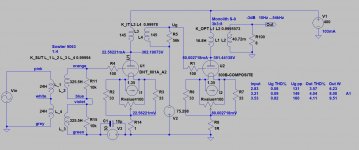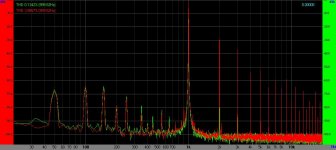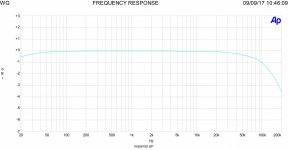Well no pain no gain. yes 10Y nice but at what price for Nos pcs, are there new production 10Ys ?Maybe, maybe not. ;-) DHT driving DHT makes for a more complicated power supply and potentially more noise. A triode-wired pentode or beam-power tube will have better transconductance and is much easier (and cheaper) to implement. That said, a 10Y driving a 300B is a very nice sound. ;-)
Sample:
1:4 SUT, IT loaded 801a, 300B, 3k3:8 SET.

NOS 10Y/801/801a are rare and costly, but Elrog now make new 801a too ... but it's costly too.
https://www.elrog.com/prices/
1:4 SUT, IT loaded 801a, 300B, 3k3:8 SET.

NOS 10Y/801/801a are rare and costly, but Elrog now make new 801a too ... but it's costly too.
https://www.elrog.com/prices/
I hope LTSpice is not very accurate with the distortion figures for that circuit, otherwise it looks horrendous...especially for the price of those components.
This means 2a3 as driver is more economical & we still can get great sound. Off course we can do Sakuma style 300B driving 300B but then its only 1 flavor of sound. LolSample:
1:4 SUT, IT loaded 801a, 300B, 3k3:8 SET.
View attachment 1142647
NOS 10Y/801/801a are rare and costly, but Elrog now make new 801a too ... but it's costly too.
https://www.elrog.com/prices/
2A3 gain is -about- half as 10Y/801 (about 8x), so 1:4 SUT + 2A3 hasn't enough gain to drive 300B grid swing (at 2V RMS input).
If power tube (300B) biased -for example- to 80V, the swing peek -to A1- is 80V, i.e. 56.6V RMS.
The required (VAS+driver stage) gain is 56.6/2 (grid voltage/input voltage) ... about 28.
If you use SUT with 4x gain (1:4, practically a little lower), the driver gain must be -at least- 28/4 = 7.... plus some headroom.
If power tube (300B) biased -for example- to 80V, the swing peek -to A1- is 80V, i.e. 56.6V RMS.
The required (VAS+driver stage) gain is 56.6/2 (grid voltage/input voltage) ... about 28.
If you use SUT with 4x gain (1:4, practically a little lower), the driver gain must be -at least- 28/4 = 7.... plus some headroom.
Thank you for the tutorial euro21.
In theory it seems like 2a3 driver isn't optimum but in listening it does not appear so. Lots of drive & very good prat factor
In theory it seems like 2a3 driver isn't optimum but in listening it does not appear so. Lots of drive & very good prat factor
I've used both 6C4C (6B4G) and 46 as drivers and they were both excellent - as you say lots of drive & very good prat factor. That's a good description. But as Bela says, they don't have enough gain with a 1:4 step-up. Maybe with sensitive speakers they could work but on paper just like he says you want a driver with a gain (mu) of 7 or more. So I use a 10Y.
I don't use a preamp because I want just 2 tube stages, not 3. The 1:4 step-up might be considered a substitute for a preamp, but it's situated in the amp so it needs a typical 2V input. It drives my Wharfedale Program 30D-6 bookshelf speakers fine in my smallish room, which is 3.5 x 4.5 metres. I don't listen loud. Which is why I can use a 2a3 and don't need to go to a 300b.
The only way I would consider a third tube stage is if it were on the output of the DAC as essential amplification. I just have a ready-made DAC with an op-amp output. That could be looked at in the future but it isn't a pressing need.
Good questions!
The only way I would consider a third tube stage is if it were on the output of the DAC as essential amplification. I just have a ready-made DAC with an op-amp output. That could be looked at in the future but it isn't a pressing need.
Good questions!
Yes - to me. Every tube stage takes away some of the transparency that can be so lovely with DHTs. The sound just gets a little thicker. When I hear that I just want to rip the stage out! Just like the sound gets a little thicker with IDHTs. I like the sound to be crystal clear or as near to it as possible. I found that a good transformer seems to affect the clarity less than a whole tube stage, assuming it's good.
So I wanted to add my thoughts here on this thread. I have most of the 300b’s mentioned here. I am using them in an Elekit TU-8600S Lundahl and TU-8900 with Lundahl driving horn speakers that are like 115-120 db efficient.
My opinion is that the EML300B is the best. It has a very good build quality and the sound is just to my taste. This is like tasting fine wines, everyone has their favorite flavors. I like the KR and the Linlai E300B a lot but the EML is just hard to beat. The E300B is a little bit dryer sounding than the EML, but with the right combination of input and driver tubes it gets very good. I could live with it probably forever, but once you’ve heard the EML….. And KR is very nice as well. I feel like the EML is as good or better but with a lower price. The KR is pricey.
I don’t use any mesh plate tubes. None of my amplifiers are set up for mesh plate. So far the 8900 sounds best with EML2A3. It has just barely enough power for my listening levels but wow I love it. The 8600 with 300B has plenty of power and slam in my system, but I would say that the 8900/2A3 combo is a bit more transparent and open but lacks some of the slam I get from the 300B. That’s my two cents.
Cheers Thomas
My opinion is that the EML300B is the best. It has a very good build quality and the sound is just to my taste. This is like tasting fine wines, everyone has their favorite flavors. I like the KR and the Linlai E300B a lot but the EML is just hard to beat. The E300B is a little bit dryer sounding than the EML, but with the right combination of input and driver tubes it gets very good. I could live with it probably forever, but once you’ve heard the EML….. And KR is very nice as well. I feel like the EML is as good or better but with a lower price. The KR is pricey.
I don’t use any mesh plate tubes. None of my amplifiers are set up for mesh plate. So far the 8900 sounds best with EML2A3. It has just barely enough power for my listening levels but wow I love it. The 8600 with 300B has plenty of power and slam in my system, but I would say that the 8900/2A3 combo is a bit more transparent and open but lacks some of the slam I get from the 300B. That’s my two cents.
Cheers Thomas
Also I forgot to mention that I have two pair of the JJ 300B. One pair sounds better than the other. These tubes are just too dry sounding for my taste. And at the other end of the spectrum is the Cossor WE300B, this tube is very liquid warm velvety sounding. Again it’s too much in the opposite direction for my taste. The Cossor has soft pillowy bass and sounds kind of bloated and dark. These tubes are really not in the same league as the EML, Linlai E or KR. Again this is just my opinion and my findings with Elekit and Sunvalley amps.
Are you talking about the standard EML300B or are you talking about the mesh/XLS version?So I wanted to add my thoughts here on this thread. I have most of the 300b’s mentioned here. I am using them in an Elekit TU-8600S Lundahl and TU-8900 with Lundahl driving horn speakers that are like 115-120 db efficient.
My opinion is that the EML300B is the best. It has a very good build quality and the sound is just to my taste. This is like tasting fine wines, everyone has their favorite flavors. I like the KR and the Linlai E300B a lot but the EML is just hard to beat. The E300B is a little bit dryer sounding than the EML, but with the right combination of input and driver tubes it gets very good. I could live with it probably forever, but once you’ve heard the EML….. And KR is very nice as well. I feel like the EML is as good or better but with a lower price. The KR is pricey.
I don’t use any mesh plate tubes. None of my amplifiers are set up for mesh plate. So far the 8900 sounds best with EML2A3. It has just barely enough power for my listening levels but wow I love it. The 8600 with 300B has plenty of power and slam in my system, but I would say that the 8900/2A3 combo is a bit more transparent and open but lacks some of the slam I get from the 300B. That’s my two cents.
Cheers Thomas
The EML300B [standard type] is my favourite, too. The sound is consistently delightful, and the construction is very obviously superior to most of the other modern production types. Mine have been running for over seven years, and remain absolutely stable for measured parmeters.
It is also the only type that does not continue to sound, if the needle is suddenly lifted from the record - some kind of mechanical resonance is triggered in most types.
It is also the only type that does not continue to sound, if the needle is suddenly lifted from the record - some kind of mechanical resonance is triggered in most types.
- Home
- Amplifiers
- Tubes / Valves
- 300B advice


